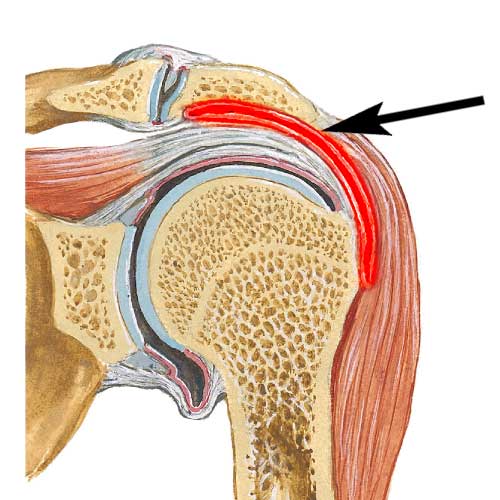
What is shoulder bursitis & impingement?
Shoulder impingement, also known as subacromial impingement or shoulder bursitis, is caused by compression or pinching of the rotator cuff tendons and soft tissues at the top of your shoulder against the top of the shoulder blade. It occurs when there is reduced space between the acromion (a bony projection of the shoulder blade) and the rotator cuff tendons and bursa (fluid-filled sac that acts as a cushion at the top of the shoulder). This compression can lead to pain, inflammation and limited range of motion.
The main reasons why your shoulder may develop shoulder impingement include:
Structural factors: Certain anatomical variations, such as a bony outgrowth of your acromion, also known as a hooked acromion, a downward-pointing acromion, or a generally narrow space beneath the acromion, can cause shoulder impingement. However, the main diving factor for shoulder impingement is inflammation or injury of the rotator cuff. The rotator cuff consists of four muscles and their tendons that encircle the shoulder joint. The rotator cuff provides stability to your shoulder and helps your shoulder move.
- Repetitive overhead activities: Activities that involve repetitive overhead motions or excessive use of the shoulder joint can contribute to the development of shoulder impingement. This main include continuous work exposure, throwing, lifting heavy objects or taking part in specific sports.
- Muscle imbalances and weakness: Imbalances in the muscles surrounding the shoulder joint and your shoulder blade (scapula) can lead to abnormal movement. This is can change the way your shoulder sits at rests against your chest wall and how it moves. This, in turn, can increase the risk of of shoulder impingement.

Subacromial Bursa
The subacromial bursa is a fluid filled cavity that lies under the acromion and the deltoid muscle. It allows the underlying rotator cuff tendons to slide smoothly past the acromion.

Subacromial Bursitis
The subacromial bursa may become inflammed and painful in conditions affecting the shoulder, such as rotator cuff tears, external compression or muscle imbalance.

Acromial Spur
The subacromial bursa may become inflammed and painful in cases of extrinsic compression of the rotator cuff muscles, such as an acromial spur.
Shoulder Bursitis Treatment
Rest and activity modification:
Pain management:
Exercises:
Acupuncture/ Dry Needling:
Extracorporeal Shockwave Therapy:
Laser therapy:
This is also known as cold laser or low-level laser therapy. It uses a specific type of light that may help to promote healing and inhibit pain naturally.
How do you know if you have shoulder bursitis?
The symptoms of shoulder impingement can vary depending on why you have developed shoulder impingement. Most commonly, you may have pain at the tip of the shoulder with shoulder abduction (moving the arm away from your body). Common symptoms you may experience include:
Pain: Typically felt at the tip or the front of the shoulder. Your pain may get worse with shoulder activity, especially with moving your shoulder above your head. Sometimes you can also have persistent pain with prolonged sitting. In some cases, your pain could also persist throughout the night and make finding a comfortable position in bed difficult.
Weakness: Difficulty or weakness in performing certain shoulder movements or lifting objects can be part of shoulder impingement. This is particularly the case if the underlying case of impingement is a tear in your rotator cuff tear. You may find that lifting objects or certain movements or sports are tricky to do.
Limited range of motion: Reduced ability to move your shoulder usually gives hand in hand with pain and weakness. This is particularly the case with activities involving abduction (raising the arm to the side) and external rotation (rotating the arm outward) of your shoulder.
Can shoulder bursitis and impingement be reversed?
Do I need shoulder decompression surgery?

